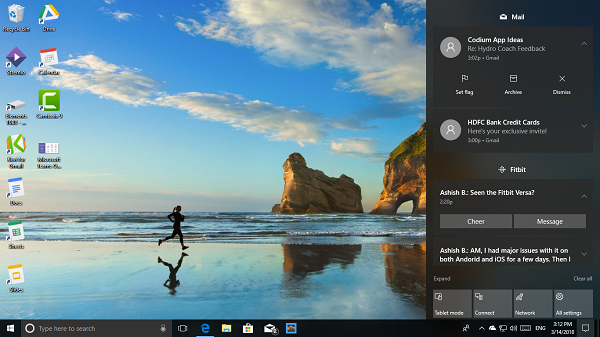What is the Notifications and Action Center
If you are wondering where this came from, then this is the central location. which technically is positioned on the extreme right, for all notifications on Windows 10. You can always open your action center, and check which notifications need your attention, or dismiss the ones not required. These notifications also offer quick actions. More on the Notifications and Action Center here
How to Customize the Notification area on the Taskbar
Many don’t know that messages that show up from time to time on the bottom-right of the Taskbar are also part of notifications. Often called as System Tray, it houses apps and OS components. If you have too many in that area, it becomes annoying. Read our detailed post on Start Menu & Taskbar customization here.
Back to Action Center
The image below shows how a typical action center looks like. You have notifications stacked on top of each other, some messages have actions (Email notifications lets you archive), and they are all sorted by apps. In the end, you have quick toggle/ action buttons which let you change state or sometimes open an app like settings.
If you choose to expand, you can see more Quick Action buttons. By default, there are 7 to 8 action buttons available. You get to see 4, and rest show up when you expand – but you can if you wish to change the order or remove/add Quick Action buttons.
Pro Tip: If you wish to completely disable the Action Center in Windows 10, it is possible to do so.
Control & reduce Notifications in Windows 10
Now that you are done with the basics, let’s get to know how to lower down a number of notifications. There are two ways of doing this. First is from the global settings, and second from the action center. Since we are already here, let’s have a look at the first one. Under Settings > System > Notifications and actions, you have a list of toggles.
Managing Global Notification Settings:
Lock Screen Options:Show Hide notification on the lock screen.Show / Hide reminders and incoming VoIP call on the lock screen.Apps:Turn on or off notifications from Apps, and other senders.In the end, you have a list of Senders or Apps which include apps like Fitbit, Cortana, etc. You can choose to turn them off individually.
You can also choose to disable Windows Welcome Experience, Tips and Tricks notifications, and hide notifications when duplicating screen. This is useful if you are connecting to the projector for a demo.
Making choices from the Action Center
In my experience, instead of turning them from the above-mentioned area, it is better to do it as you get it. The notifications are all stacked in the action center, and if you right-click on any of them, you get options right away. I am using “Mail” app as an example here.
When you choose to increase priority, notifications from that app will always be on top. The third option takes you to Apps settings where you can choose more granular control. We will talk about it a bit. This method works based on your experience, and usage. So if there is an app which is sending out notification for the first time, doesn’t miss your attention.
Control where Notifications Show & How to hide them
If you wish notifications from few apps should not be visible as a pop-up or on the lock screen, it is possible to control it. At times, you need your privacy, and Windows 10 offers you right choices. Like I said above, The third option takes you to Apps settings where you can choose more granular control. The options are-
Using these, you can completely hide notifications from apps if you wish to. To change, you need to go back to Notifications & Actions > select the app you disabled, and then change it. Pro Tip: You can turn off Notification sounds or you can take granular control of each app and the select sound of your choice.
How to disable notifications temporarily
If you are working on something important, and do not want to get disturbed for a couple of hours, you can use Quiet Hours. Right click on right most corner of the taskbar, and you will see options for:
Turn on quiet hours.Don’t Show app icons.Don’t show a number of new notifications.
Quiet Hours can be configured very easily, and the above option lets you turn it on off when you wish. How do you manage notifications on Windows 10? Do you use Quite hours or control it on a per-app basis. Do let us know in the comments.

